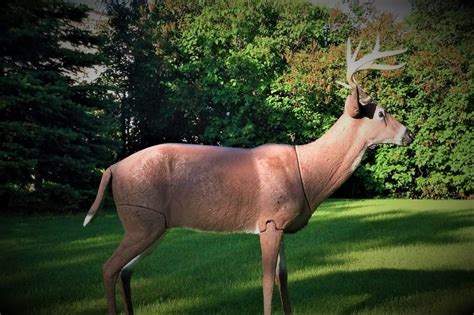How To Use A Deer Decoy
Ronan Farrow
Apr 03, 2025 · 3 min read

Table of Contents
How to Use a Deer Decoy: A Comprehensive Guide for Hunters
Deer hunting can be challenging, but using a decoy can significantly increase your chances of success. A well-placed decoy can draw in deer, giving you the perfect shot. However, understanding how to use a deer decoy effectively is crucial. This guide provides a comprehensive overview of deer decoy usage, from choosing the right decoy to optimizing its placement and enhancing its effectiveness.
Choosing the Right Deer Decoy
The first step to successful decoy hunting is selecting the appropriate decoy for your hunting environment and target species. Consider these factors:
Type of Decoy:
- Doe Decoys: These are generally the most effective, as bucks are often attracted to the presence of receptive females. A well-placed doe decoy can draw in multiple bucks.
- Buck Decoys: These can be effective, particularly during the rut, but using them requires careful consideration of positioning and timing. An aggressively posed buck decoy can sometimes deter rather than attract.
- Fawn Decoys: While less common, fawn decoys can be useful in situations where a mother deer is likely to be nearby, looking for her young.
Material and Realism:
- Lifelike Appearance: Look for decoys with realistic coloring, posture, and detail. A high-quality decoy will look convincingly natural.
- Durability: Choose a decoy made from durable materials that can withstand the elements and potential damage.
Size and Posture:
- Natural Size and Posture: A decoy that is too large or too small can arouse suspicion. A natural posture is crucial for a convincing presentation.
- Variety in your Arsenal: Having several decoys with different postures adds to their overall effectiveness.
Strategic Placement of Your Deer Decoy
The placement of your decoy is paramount to its success. Consider the following points:
Natural Surroundings:
- Concealment: Place the decoy in a location that offers some natural concealment. This prevents it from looking out of place.
- Natural Cover: Utilize existing features like brush, trees, or rocks to blend your decoy into its surroundings.
Wind Direction:
- Downwind Placement: Position your decoy downwind of your hunting position. This allows the deer to smell the decoy before seeing it, maximizing its effectiveness.
Line of Sight:
- Clear Shot: Ensure that your hunting position allows for a clear shot at the deer, without obstructing your view.
Distance from your Stand:
- Optimal Distance: Experiment to find the optimal distance between your stand and the decoy, typically 20-40 yards. This allows for a natural approach from the deer.
Enhancing the Effectiveness of Your Decoy
Beyond proper placement, other techniques can improve your decoy's performance:
Scent Control:
- Minimize Human Scent: Employ scent-eliminating techniques to avoid alerting deer to your presence. This includes using scent-free clothing and laundry detergent.
Movement:
- Slight Movement: Adding subtle movement to your decoy can enhance realism and attract deer. This can be achieved through a simple motorized decoy or carefully placed flags or natural elements moving slightly in the wind.
Timing:
- Peak Activity: Use the decoy during peak deer activity hours. Morning and evening are usually the best times.
Troubleshooting Common Issues
- Deer Avoiding the Decoy: This could be due to poor placement, unnatural appearance, or strong human scent. Adjust the placement, consider a more lifelike decoy, or enhance your scent control.
- Deer Investigating But Not Approaching Close Enough: Try adding a slight movement to the decoy or adjusting its position to offer a more enticing approach.
By following these guidelines, you’ll significantly improve your chances of a successful hunt. Remember that patience and observation are key to understanding deer behavior and optimizing your decoy's use. Happy hunting!
Featured Posts
Also read the following articles
| Article Title | Date |
|---|---|
| Born In 1931 How Old In 2024 | Apr 03, 2025 |
| How Big Are Space Marine Miniatures | Apr 03, 2025 |
| How Was Work Response | Apr 03, 2025 |
| How To Write Washu Supplemental Essay | Apr 03, 2025 |
| How Big Is A Slab Of Marble | Apr 03, 2025 |
Latest Posts
-
How Big Is Lake Sunapee
Apr 03, 2025
-
How Big Is Lake James Indiana
Apr 03, 2025
-
How Big Is Lake Delavan Wi
Apr 03, 2025
-
How Big Is Lake Delavan
Apr 03, 2025
-
How Big Is Lake Blue Ridge
Apr 03, 2025
Thank you for visiting our website which covers about How To Use A Deer Decoy . We hope the information provided has been useful to you. Feel free to contact us if you have any questions or need further assistance. See you next time and don't miss to bookmark.
